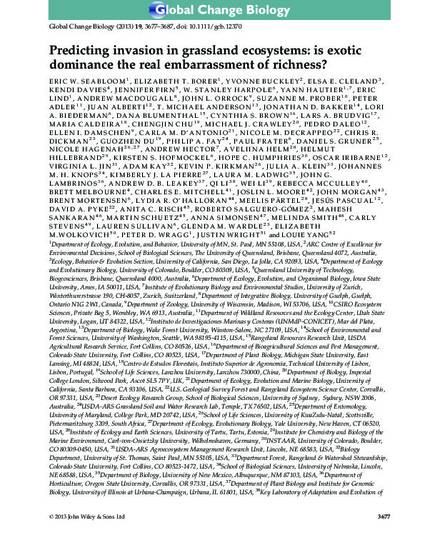
Invasions have increased the size of regional species pools, but are typically assumed to reduce native diversity. However, global-scale tests of this assumption have been elusive because of the focus on exotic species richness, rather than relative abundance. This is problematic because low invader richness can indicate invasion resistance by the native community or, alternatively, dominance by a single exotic species. Here, we used a globally replicated study to quantify relationships between exotic richness and abundance in grass-dominated ecosystems in 13 countries on six continents, ranging from salt marshes to alpine tundra. We tested effects of human land use, native community diversity, herbivore pressure, and nutrient limitation on exotic plant dominance. Despite its widespread use, exotic richness was a poor proxy for exotic dominance at low exotic richness, because sites that contained few exotic species ranged from relatively pristine (low exotic richness and cover) to almost completely exotic-dominated ones (low exotic richness but high exotic cover). Both exotic cover and richness were predicted by native plant diversity (native grass richness) and land use (distance to cultivation). Although climate was important for predicting both exotic cover and richness, climatic factors predicting cover (precipitation variability) differed from those predicting richness (maximum temperature and mean temperature in the wettest quarter). Herbivory and nutrient limitation did not predict exotic richness or cover. Exotic dominance was greatest in areas with low native grass richness at the site- or regional-scale. Although this could reflect native grass displacement, a lack of biotic resistance is a more likely explanation, given that grasses comprise the most aggressive invaders. These findings underscore the need to move beyond richness as a surrogate for the extent of invasion, because this metric confounds monodominance with invasion resistance. Monitoring species' relative abundance will more rapidly advance our understanding of invasions.
Available at: http://works.bepress.com/lori_biederman/2/

This article is from Global Change Biology 19 (2013): 3677, doi:10.1111/gcb.12370